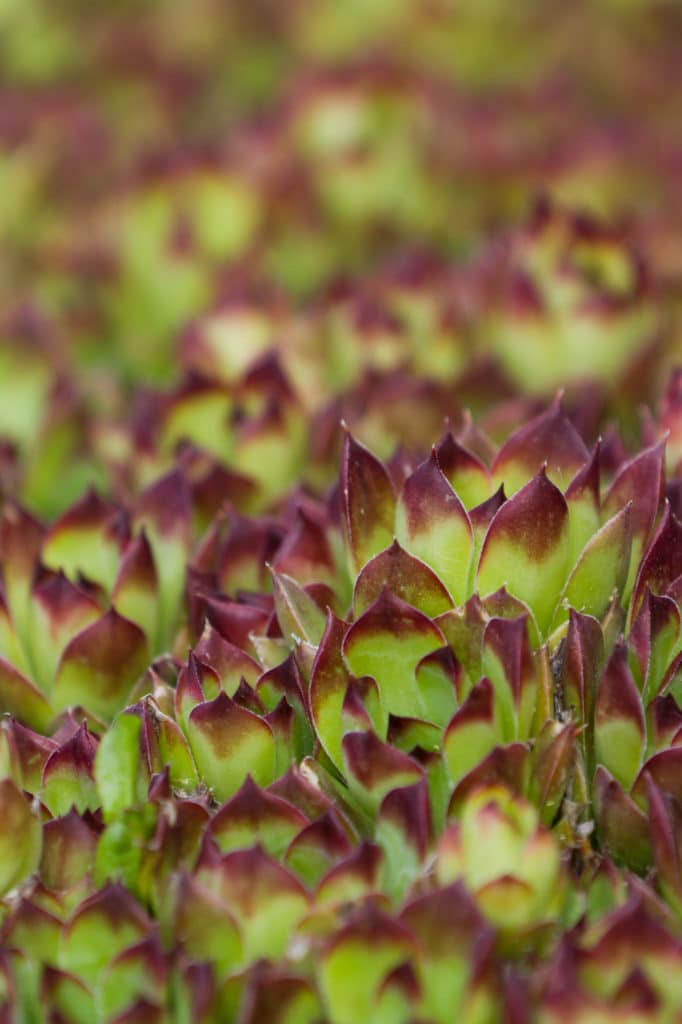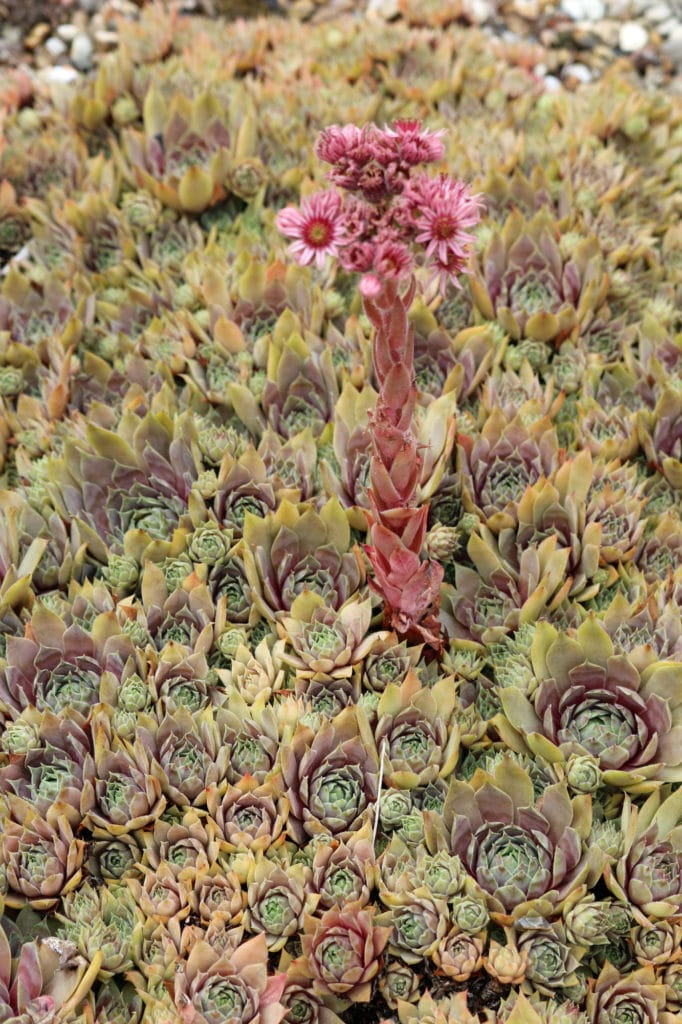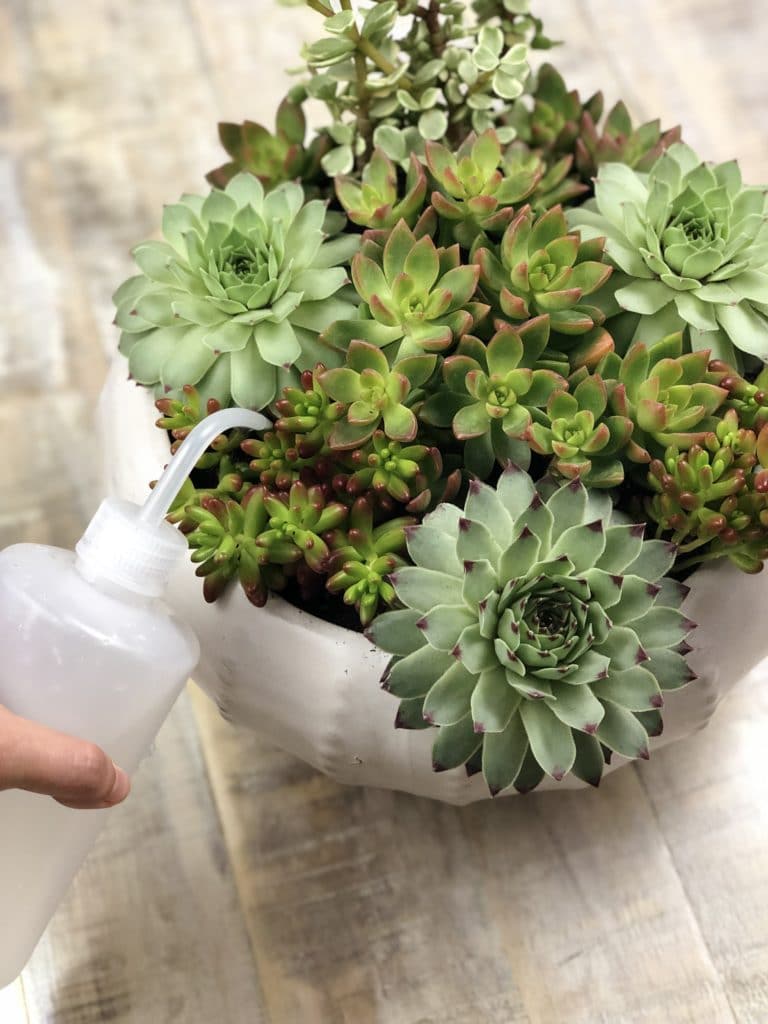How to Care for Hens and Chicks Succulents
Interested in learning how to care for Hens and Chicks succulents? You’re going to love these low-maintenance and cold-hardy succulents!
Hens and Chicks, also called Sempervivums, are some of the prettiest succulents you can grow so once you learn how to care for them, you’ll probably want to keep adding more and more of them to your collection – they really are that special!
Hens and chicks succulents come in different varieties and colors, but they all share the same basic care guidelines.
Personally, I adore hens and chicks because I think they are SO adorable in DIY crafts.
They’re very adaptable and easy to work with so I love to use them for fun projects like these DIY pumpkin succulents; they make the holidays just a little more fun.
So if you’re ready to start caring for hens and chicks, let’s talk about the most important care tips so you can get going.

What Exactly are Hens & Chicks Succulents?
Great question. “Hens and chicks” is a nickname given to Sempervivum succulents because of the way they grow.
Each plant lives around three years and produces many offshoots before blooming and then dying. It’s why they’re categorized as monocarpic succulents.
One large succulent aka the mother “Hen” produces tiny offshoots aka the “Chicks”, and they all grow together in one mound.
The chicks grow attached to the hen unless they’re physically removed. The baby chick will start producing its own offset after one growing season and the cycle continues on and on!
Over time, Hens and Chicks Sempervivums can form dense mats which is why they grow so well as ground covers and in rock gardens.
They’re also incredibly resilient to extreme weather conditions and thus are classified as “hardy succulents”.
Hardy succulents are pretty tough and they can withstand freezing temperatures down to -20F.

This makes them perfect for people who live in a zone with harsh winters; it means you don’t have to worry about bringing your succulents indoors for the winter! .
Some Hens and Chicks varieties are covered in a cotton-like film that actually resembles spider webs – yikes!
So if you’re a big Halloween lover, I think you’d love using Hens & Chicks succulents for crafts around the house.
Another common Hens & Chicks variety is called Sempervivum Blue Boy and it is gorgeous! The tips of the leaves turn a deep burgundy color, which makes this plant the perfect stand-out in potted arrangements.
It’s one of my favorites because it’s so elegant and beautiful. The tips of the leaves are very pointed (be a little more careful when handling them!) and they’re also not as fleshy as other succulents like Echeverias.
Still, Sempervivums are a great addition to any succulent garden. They can definitely hold their own amongst a sea of beautiful rosettes.
Some other Hens and Chicks qualities include:
- They can change colors pretty rapidly
- They’re monocarpic which means the Hen will they die after flowering BUT the chicks will survive and keep spreading out
How to Plant Hens and Chicks Succulents
You can plant hens and chicks succulents the same way you’d plant other succulents: simply transfer your new plant from its plastic pot to a new pot or into the ground, making sure the root system is completely covered in soil and the leaves sit above the soil.
Always keep in mind that good drainage is KEY to their survival, so planting in a pot with a drainage hole is ideal.
Terra-cotta pots are great because they wick moisture away from the pot, which helps the root system avoid soggy soil.
Using a good cactus mix is preferred when growing any kind of succulent because this type of soil mix is made to be fast-draining.
Regular potting soil simply retains too much water for succulents and cacti so its best to avoid this type of soil if you’re a beginner and aren’t very comfortable with watering your succulents yet.
If you do use regular potting soil, you can improve the drainage and airflow of the soil by mixing in handfuls of perlite, pumice, or coarse sand.
When choosing a planting spot, keep in mind that hens and chicks enjoy getting about 6 hours of sunlight each day and they prefer filtered/indirect sunlight to full sun, especially in the heat of summer, as they can scorch.
They can survive in full sun but they will need additional protection on days that reach above 90 degrees.
During heat waves, it’s a good idea to move your pots to a sheltered area or build a tarp with shade cloth over your in-ground succulents to provide some shade. This helps protect them against sunburn.
How to Water Hens and Chicks Succulents
Water sempervivums the same way you would water your other succulents: water deeply only when the soil feels dry a few inches deep into the soil, then don’t water again until the soil feels dry.
Letting most of the soil dry out between waterings is how succulents prefer to be watered.
Here are more watering tips :
Aim to water the soil directly; it’s the root system that needs water. Hens and chicks succulents soak up water through their roots and then store it in their leaves.

If you’re growing them indoors, try to not get the leaves wet. Prolonged exposure to moisture can lead to soggy and rotting leaves.
Don’t overwater. Make sure the soil feels dry to the touch a few inches deep into the pot.
Watering too frequently may not only lead to root rot, it can also lead to fungus gnats and pests.
If your pot does not have a drainage hole, then you’ll need to water much more carefully since the water will have nowhere to drain.
My best tip here is to water slowly and water only enough so that the soil feels slightly moist.
If your pot has a saucer, always throw out the remaining water that collects after waterings. Allowing your pot to sit in a water-filled saucer is not good for the root system!
In fact, it’s one of the fastest way to kill a succulent.
Dividing Hens and Chicks Succulents
Dividing hens and chicks is a really fun part of growing them! It might seem intimidating but it’s a great way to spread out your succulents or use them in different potted arrangements.
As the plant ages, the “hen” produces about four little offshoot plants aka “chicks”.
Once the chicks are large enough in size (wait until they’re at least the size of a quarter), you can gently pull them away from the hen to separate them.
Place them on top of cactus soil and water them a few days later.
They’ll eventually grow roots and produce their own “chicks”.
Garden Design Tips for Hens and Chicks Succulents
Hens and chicks are perfect for rock gardens.
They grow beautifully between the crevices of rocks, so adding a few large stones in your landscape and planting them along or in between the rocks can look really beautiful.
The more that hens and chicks populate, the prettier the landscape will be.
Personally, I love using hens and chicks in my DIY crafts. They are so drought tolerant so they can go weeks without much water at all, particularly in the fall and winter when they’re dormant.
I created a fall tablescape last year that included faux pumpkins and two different varieties of sempervivums.
My DIY Pumpkin Succulents Table Centerpiece turned out so beautifully and it was incredibly low-maintenance. I encourage you to try out in a DIY craft this Fall!
Aside from DIY crafts, hens and chicks make wonderful additions to container arrangements.
Use them alone or mix and match them with other succulents for a bigger impact.
Since they’re low-growing plants, my recommendation is to use smaller, shallow pots so that they don’t get lost in large containers.
That about covers the most important hens and chicks care guidelines. Remember to have fun planting and creating with sempervivums – these hardy succulents make gardening so care-free!
Plus, they’ll reward you with more plants as they grow older and produce more offshoots.
If you find yourself wanting to grow more succulents, I have plenty of other posts that will guide you, step-by-step!
They’re my favorite plants and I love helping others grow them.
WANT TO LEARN MORE ABOUT SUCCULENT CARE?
Check out the posts below to find out more about succulents and how to help them thrive and look their very best!
How to Care for String of Bananas
How to Water Succulents
Do Succulents Die After Flowering?
How to Care for Succulents
Why Your Succulents Grew Leggy and Stretched-Out
How to Grow Aloe Vera
Hi Natalie, I am just getting started with hens and chicks and I found your tips so very helpful! Thanks so much for sharing your knowledge!
So glad this post helped you! Good luck!
I have been given a potted Hens and Chicks and I am about to transplant a few Chicks that are the size of a quarter coin… thank you for all of your great tips.. cheers
So glad to help!
So helpful! I love your post. Wish you had a paper back book for purchase.
Thank you, Sharron! I don’t have a paperback book BUT I do have an eBook bundle available now! You can find it by clicking on the tab at the top of my blog that says “The Succulents Accelerator Bundle”. : )
I love Hens and chicks. I have some growing in my rock garden outside and we live where the temperature gets extremely cold in the winter (down to -20 F at times). I was surprised and happy when they survived last winter. I do struggle with watering my succulents (I have a wide variety) without overwatering or underwatering. Also when I water deeply with any succulents they always seem to rot and die. I’m very careful to test before watering and empty the saucers of water. I’m concerned about some grapto succulents I recently purchased. I know the soil is dry but the leaves are getting yellow and translucent and falling off which I have read usually means too much water. I’m not sure what to do. Do you have any suggestions? Thanks for your sites and extensive information regarding succulent care.
Hi Lisa, so sorry for the late response, sometimes comments get lost within the spam comments!
How is your grapto sedum doing? Translucent and yellow leaves does indicate overwatering – if you let the soil dry out before watering again it should help the situation. If the stem looks black, you’re dealing with a rotted root system so it’s best to just cut off any healthy part of the plant above the rot to replant in new soil.